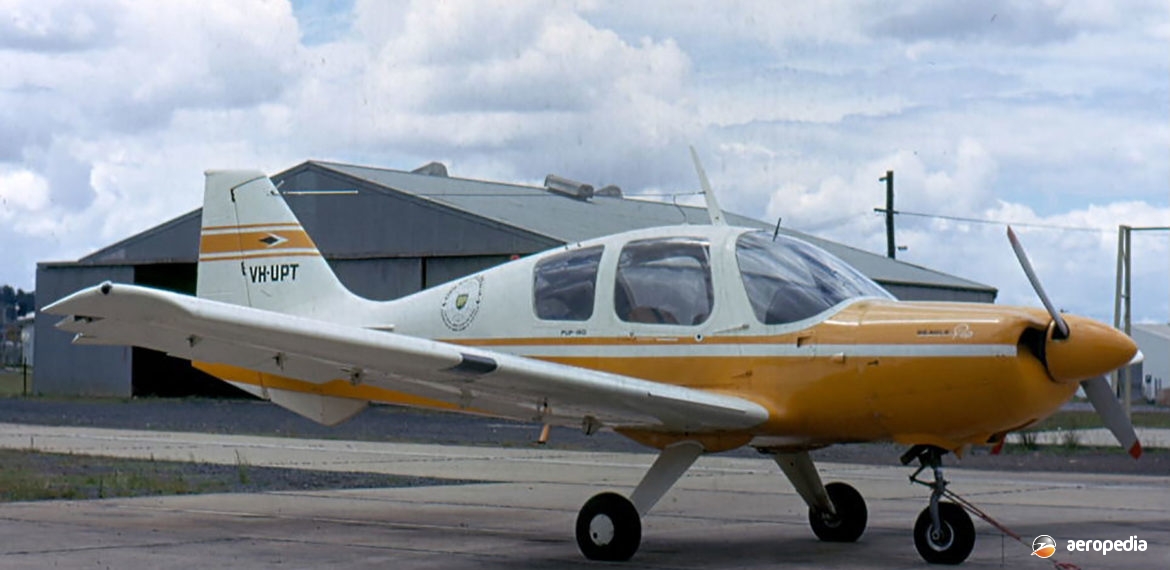Photograph:
Beagle Pup VH-UPT (c/n 103) at Bankstown, NSW (David C Eyre)
Country of origin:
United Kingdom
Description:
Four-seat light cabin monoplane
Power Plant:
One 112 kw (150 hp) Lycoming O-320-A2B four-cylinder horizontally-opposed air-cooled engine
Specifications:
- Wingspan: 9.45 m (31 ft)
- Length: 7 m (23 ft 2 in)
- Height: 2 m (6 ft 9 in)
- Wing area: 11 m² (119.5 sq ft)
- Max speed at sea level: 222 km/h (138 mph)
- Economical cruising speed at 65% power at 2,438 m (8,000 ft): 203 km/h (126 mph)
- Rate of climb at sea level: 256 m/min (840 ft/min)
- Stalling speed flaps down: 80 km/h (50 mph)
- Service ceiling: 4,267 m (14,000 ft)
- Max range: 1,110 km (690 miles)
- Empty weight: 499 kg (1,100 lb)
- Loaded weight: 862 kg (1,900 lb)
History:
The Beagle Pup was designed as a trainer and sport aircraft to meet the needs of both the professional pilot training school, the flying club, and the private pilot. The prototype, the Pup 100, flew for the first time on 8 April 1967. The following pre-production aircraft, c/ns 3 and 4, were flown on 4 October 1967 and 17 January 1968, the prototype of the Pup 150 (c/n 2) being a static test airframe.
Deliveries of production aircraft began in April 1968 to British Aero Clubs and to Swiss training schools. The Pup 100 accommodated four persons, usually two adults and two children; and the Pup 150 seated three adults and one child. Production aircraft were built at Shoreham in West Sussex and Rearsby in Leicestershire, the latter being the old Auster Aircraft works.
Twenty-one Pups were allotted Australian registrations (VH-EPA to VH-EPV and VH-UPT) but production ceased after a short time and only five Pups were actually imported, the others, which were eventually completed, remaining in the United Kingdom or being sold elsewhere. The Australian aircraft were VH-EPA (c/n 016), VH-EPB (c/n 075), VH-EPC (c/n 084), VH-EPD (c/n 085), VH-EPE (c/n 093) and VH-UPT (c/n 103). A few were flown for a short time with aero clubs but were then sold to private owners. All of the Australian machines were Series 2 aircraft (also known as the Pup 150).
The Series 1 differed in having a 75 kw (100 hp) Rolls Royce/Continental O-200-A engine; whilst the Series 3 was fitted with a 119 kw (160 hp) Lycoming O-360-A engine.
A few survive in Australia and are airworthy, but VH-UPT withdrawn from service in December 1974; VH-EPB crashed at Berwick, VIC on 22 November 1969; VH-EPC crashed near Bacchus Marsh, VIC on 13 March 1972; VH-EPD was damaged by a storm at Mascot on 5 May 1971; and VH-EPE became VH-DDS on 23 November 1993 but was extensively damaged in a landing accident at Camden, NSW in the late 1990s.
A development of the series was designed specifically as a military trainer and, known as the Bulldog, was fitted with a 149 kw (200 hp) Lycoming IO-360-A1B6 engine. Examples of this model have seen service with the Royal Air Force, Sweden, Malaysia and Kenya and, as these were retired from 2001 onwards, they became available for purchase by private owners. Some numbers have been registered in the United Kingdom and the United States. A couple of Australians have shown interest in importing examples but the costs of bringing them up to civil airworthiness standards for a time proved prohibitive.
Beagle Aircraft, during production of its range of aircraft, ran into financial problems and closed down. However, as contracts had been let for production of the Bulldog, these aircraft were built by Scottish Aviation (Bulldog) Ltd at Prestwick in Scotland to meet the outstanding orders.
Two Series 2 Pups were imported to New Zealand. ZK-CYP (c/ns B121/020) was registered to Adsal Ltd of Wellington on 19 February 1969. However, the aircraft suffered some damage during transit from the United Kingdom and was shipped back. A second aircraft was imported, this aircraft also becoming ZK-CYP² (c/n B121/044) and also being registered to Adsal Ltd of Wellington on 25 July 1969, then with the Canterbury Aero Club and a number of other owners, and survives.

